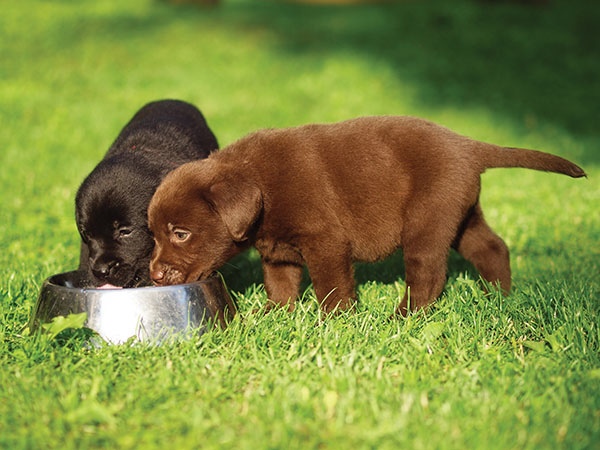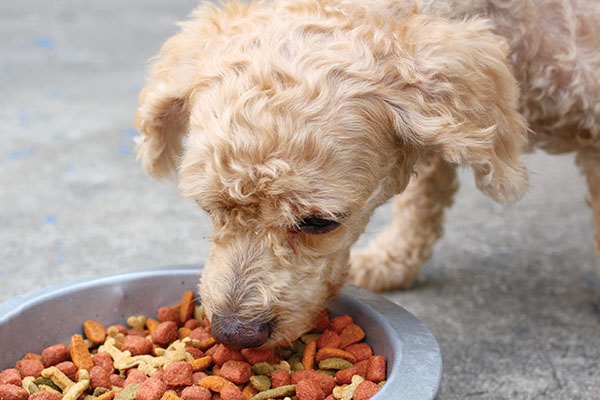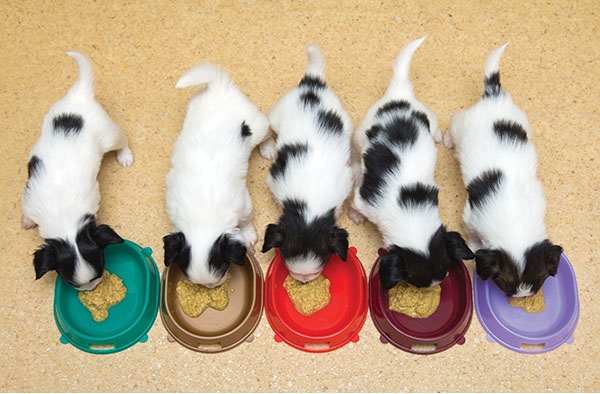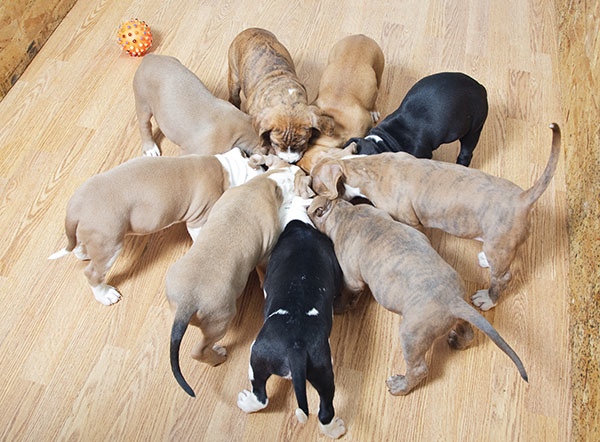Chapter 9: Feeding and Nutrition
Nutrition is one of those tricky canine topics where you ask six people a question and you get seven different answers. It is a complicated and frequently contentious topic—with some people, more so than politics or religion! What you feed (or don’t feed) can have a significant impact on your puppy’s future development. Plenty of “experts” are willing to tell you what and what not to feed your puppy, and how you are likely harming your puppy if you don’t follow a particular diet.
Sorting nutritional fact from fiction is a daunting task for many owners. Doubly frustrating is that canine nutritionists don’t always agree on what types of foods are best for dogs or even how much fat, protein, and carbohydrates your puppy should eat. So how do you know what is best for your puppy? Let’s start with the basics.
The Importance of Good Nutrition
Good nutrition, along with exercise, helps prevent disease, promote healthy skin, build strong bones and ligaments, and provide your puppy with the best opportunity to grow into a healthy adult dog. Everything a puppy does requires energy, including everyday activities such as drinking, eating, running, jumping, and retrieving, of course, as well as such functions as breathing, stretching, yawning, and even maintaining blood chemistry, blood pressure, and body temperature.
Overall energy requirements are affected by variables that include anxiety or stress related to his transition to a new home, learning new behaviors, and experiencing new things every day. Fluctuations in weather also affect his energy requirements.
Puppies grow at an astonishing rate, and you can practically see their size and weight increasing daily—especially the larger breeds such as German Shepherds, Doberman Pinschers, and Great Pyrenees. In order to grow into a healthy adult dog, your puppy needs about twice as many calories per pound of body weight as an adult dog of the same breed. He also needs all of the nutrients—protein, fat, carbohydrates, vitamins, and minerals—in the proper amounts, because too much or too little of some nutrients can cause growth issues. Puppies who grow too slowly may not be getting proper nutrition. Puppies who grow too quickly run the risk of bone and joint problems as they mature. Whether you own a Chihuahua or a Great Dane, your puppy needs to grow at the correct rate so he can reach his genetically programmed adult size, be it 2 pounds or 200 pounds.
Not all puppies are created equal when to comes to nutrition. Some puppies have allergies to different food sources, such as beef, chicken, or fish, which can cause an array of troubles, including scratching and intestinal gas. Others are sensitive or intolerant to poor-quality ingredients and grain-based diets. Identifying food allergies can be difficult and usually requires a trip to a veterinary dermatologist.
It’s important for you to look at your puppy’s individual nutritional needs and then feed a diet that provides the correct combination of nutrients. What works for one puppy may not work for another because a puppy’s nutritional needs will change depending on his age, environment, housing conditions, exposure to heat or cold, and overall health, and the emotional and physical demands placed upon him.
Some puppies—especially herding, sporting, and terrier breeds—are constantly in motion, and the more active the puppy, the more energy he burns. As a result, some puppies require a higher intake of nutrients to fuel their bodies. As your puppy grows into an adult dog, his dietary needs will change many times. To help your puppy’s complex system run efficiently, it is important to find the diet that provides the correct balance of nutrients for his individual requirements.

Whether you’re feeding a Border Collie or a Bulldog puppy, the amount of food required will depend on your puppy’s activity level.
Know Your Dietary Components
Research indicates that owners are becoming increasingly savvier about canine nutrition—and that is a good thing. Whether your choose grain or no-grain, age-specific, or organic food, the nuts and bolts of nutrition remain the same. The six basic elements of nutrition are carbohydrates, fats, proteins, vitamins, minerals, and water.
A puppy’s energy is derived from the metabolism of energy-yielding nutrients—carbohydrates, fats, and proteins. During digestion, the body breaks down these three nutrients into four basic units that can be absorbed into the blood: carbohydrates are broken down into glucose, fats into glycerol and fatty acids, and protein into amino acids. (Amino acids are not primarily energy nutrients, but they can flow into energy pathways if needed, so they are included.)
Carbohydrates
Like much of the science of canine nutrition, carbohydrates are complicated because they come in many different forms, which a dog’s body deals with differently. Dogs are classified as omnivorous—consumers of the primary sources of carbohydrates: meats and vegetables. Interestingly, carbohydrates are not an essential part of a dog’s diet because his body can get its energy from protein. However, carbohydrates provide an excellent, cost-effective, and readily available source of dietary energy, which explains why many commercial dog foods contain somewhere between 46 and 74 percent carbohydrates.
Carbohydrates are often referred to as protein-sparing nutrients because the action of carbohydrates (and fats) in providing energy allows proteins to be used for its own unique roles. Without adequate carbohydrates, a dog’s body can use protein for energy. Protein, however, is less efficient as an energy source because its primary functions are building muscle and regulating body functions. A dog’s body must dismantle his valuable tissue proteins and use them for energy.
Carbohydrates are introduced to the diet primarily through vegetable matter, legumes, and cereal grains, such as rice, wheat, corn, barley, and oats. (Carbohydrates in commercial dog foods are usually cereals, legumes, and other plant foods.) A dog’s body breaks down carbohydrates into glucose and then into long glucose chains called starches. Glucose is the primary energy used to fuel a dog’s body. It is readily absorbed in the small intestine and is transported via blood tissues for fuel. Unused carbohydrates are stored in the body as converted fat and as glycogen in the muscles and liver.
Carbohydrates are divided into two categories: simple and complex carbohydrates. Simple carbohydrates, also known as “simple sugars,” include fructose (fruit sugar), sucrose (table sugar), and lactose (milk sugar). Simple carbohydrates require little or no digestive breakdown and are readily absorbed in the small intestine. Complex carbohydrates, which include potatoes, yams, legumes, and whole-grain flours (e.g., wheat and rye) are longer and more complex chains of simple sugars that require additional breakdown by the intestinal enzymes before they are absorbed and utilized as energy.
The right amount of carbohydrates in a puppy or adult dog’s diet is debatable and highly contested among nutritionists. Currently, no known minimum dietary requirement for carbohydrates in dogs exists because a requirement has not been established for either digestible or indigestible carbohydrates in dogs at any age.

A balanced diet, including high-quality protein, carbs, and fat, contribute to a dog’s overall health and a lustrous coat.
Fats
Fats get a bad rap even when it comes to canine nutrition. Granted, too much fat can be the culprit of some health issues, such as obesity or acute and/or chronic pancreatitis, but fats are not the dietary bad guys that some experts make them out to be.
Fats are derived from animal fats and the seed oils of various plants, and they are the most concentrated sources of food energy in your puppy’s diet. Fats account for approximately 2.25 times more metabolizable energy—the amount of energy in the food that is available to the dog—than carbohydrates or proteins.
Fats play an important role in contributing to your dog’s healthy skin and coat and aiding in the absorption, transport, and storage of the fat-soluble vitamins A, D, E, and K. Fats also increase the palatability of foods, but they contain more than twice the calories of proteins and carbohydrates. While dogs can digest fats with great efficiency—an estimated 90 to 95 percent of the fats they eat gets metabolized—fats in your puppy’s diet should be regulated. Too much fat can result in excess calorie intake, which is not good for your puppy’s health or waistline.
Fat also serves as a source of essential fatty acids (EFAs), which are specific types of polyunsaturated fats that are essential to your dog’s diet. Dogs can produce some, but not all, fatty acids, and the ones they can’t produce must be obtained through their food. For instance, two essential fatty acids—omega-3 and omega-6—are important to the health of your puppy because they have anti-inflammatory properties and help regulate blood pressure, blood clotting, and other body functions. They also contribute to your dog’s lustrous coat and help combat allergies, autoimmune conditions, arthritis, inflammatory bowel disease, and cancer-related issues, to name a few.
EFAs are found in various food sources and in varying quantities, but not all fatty acids have the same function. For example, beef fat has a lower fatty-acid percentage than poultry and pork fats. Safflower oil, on the other hand, has a much higher percentage of fatty acids than meat or poultry fats.
Fatty-acid supplementation is usually in the form of capsules or liquids; the source of the fatty acids, be it flaxseed, fish oil, or sunflower oil, depends on the specific health issue that you are trying to manage. Always consult with your veterinarian before supplementing with fatty acids—or any supplements, for that matter.

Although canines consume greens and grains, they are primarily carnivores and require meat protein to thrive.
Proteins
A protein is a compound of carbon, hydrogen, oxygen, and nitrogen atoms arranged into a string of amino acids—much like the pearls on a necklace. Amino acids are the building blocks of vital proteins that promote the development of muscles, ligaments, organs, bones, teeth, and coat. Protein also defends the body against disease and is critical when it comes to the repair and maintenance of all of the body’s tissues, hormones, enzymes, electrolyte balances, and antibodies.
There are ten essential amino acids that your puppy’s body either cannot make on its own or cannot make in sufficient quantities. These amino acids must be obtained through his diet. To make protein, a cell must have all of the requisite amino acids available simultaneously because the body makes complete proteins only. (A complete protein provides all of the essential amino acids.) If one amino acid is missing, the other amino acids cannot form a partial protein. If complete proteins are not formed, the body’s ability to grow and repair tissue is limited. Each protein is different in its ability to be broken down into amino acids.
Complete proteins, often referred to as high-quality proteins, are found in sources such as meat, poultry, fish, milk, eggs, cheese, certain grains and legumes (e.g., quinoa, lentils, and buckwheat), and some veggies and fruits (e.g., peaches, figs, and beets).
An incomplete protein source, such as beans, peas, some grains, and corn, is one that is low in one or more of the essential amino acids.
Complementary proteins are two or more incomplete protein sources that together provide adequate amounts of all essential amino acids. For example, soybean meal is not an ideal protein, and neither is corn. However, combining them forms a complementary protein because the amino acids that are deficient in one are present in the other.
You are likely to read and hear all sorts of arguments that the protein source doesn’t matter as long as all of the amino acids are present. But not all proteins are created equal. The higher the biological value of protein—meaning how efficiently your puppy utilizes the protein—the less protein he needs in his diet. For instance, eggs have the highest biological value of 94. Fish meal and milk have a value of 92. Beef is around 78, and soybean meal is 67. Meat and bone meal and wheat are around 50, and corn is 45.
The percentage of protein noted on a bag of dog food indicates the protein content, not the digestibility, of the protein. You can see why it’s important to find out from where your puppy’s protein comes. Most experts agree that the best protein sources are come from animal products.
Vitamins
A dog’s body does not extract usable energy from vitamins, but vitamins are essential as helpers in metabolic processes. Vitamins are required in only small amounts, but they are vital to your puppy’s health. Antioxidants such as vitamin C, vitamin E, and zinc help neutralize the effects of stress and environmental irritants. Vitamins are available in food sources, but they can be easily destroyed in the cooking and processing of commercial dog foods.
Certain vitamins are dependent on one another, with nearly every action in a dog’s body requiring the assistance of vitamins. Vitamin deficiencies or excesses can lead to serious health problems, such as anorexia, artery and vein degeneration, dehydration, muscle weakness, and impairment of motor control and balance.
Vitamins fall into two categories: water-soluble (B-complex and vitamin C) and fat-soluble (A, D, E, and K). Unlike humans, dogs can manufacture vitamin C from glucose, so they do not need to acquire it in their food, which means that you should never need to supplement your dog’s food with it. All other water-soluble vitamins must be replenished on a regular basis through diet. Any excesses in water-soluble vitamins are excreted in the urine.
Fat-soluble vitamins are absorbed and stored in the body’s fat cells until they’re needed, which can make oversupplementation potentially dangerous. Seek your veterinarian’s advice and read as much as you can before supplementing your dog’s food.
Minerals
Minerals do not yield sources of energy, but they are important in the overall nutritional equation because they help regulate your puppy’s complex system and are crucial components in energy metabolism. They’re also essential for strong, healthy teeth and bones, which are super important for growing puppies.
Minerals are classified as macrominerals or microminerals depending on how much of them the body needs. Microminerals, or trace elements, include iodine, iron, copper, cobalt, zinc, manganese, molybdenum, fluorine, and chromium; dogs need microminerals in very small amounts. Macrominerals, such as sodium, potassium, magnesium, calcium, and phosphorous, are needed in larger quantities.
Like essential fatty acids, essential nutrients are those that your puppy must obtain from his diet because his body cannot make them in sufficient quantity to meet his physiological needs. Commercial dog-food manufacturers add minerals and vitamins to their recipes, so it should not be necessary to supplement your puppy’s diet. Doing so can upset the delicate balance and cause serious health problems, including tissue damage, convulsions, increased heart rate, and anemia. Always consult with your veterinarian before attempting to supplement your puppy’s diet with minerals.
Water
Don’t overlook the importance of water because it is the single most important nutrient needed to sustain your puppy’s health. Water regulates a dog’s body temperature, plays an important part in supporting metabolic reactions, acts as the transportation system that allows blood to carry vital nutritional materials to the cells, and removes waste products from your dog’s system.
The amount of water a puppy or adult dog needs to consume daily varies depending on growth, stress, environment, activity, and age. Your puppy will need more water when he expends more energy while working, exercising, playing, or training because dissipation of excess heat from his body is accomplished largely by the evaporation of water through panting. Plus, dogs generally require and need to consume more water as the temperature rises. Puppies who eat primarily dry dog food will also need access to fresh water to help with digestion.
The best way to be ensure that your puppy drinks enough water is to provide him with access to an abundant supply of fresh, cool drinking water at all times. (Don’t forget to change it at least daily.) When dogs have free access to water, they will normally drink enough to maintain the proper balance of body
fluids. You might consider a device that attaches to your outside water faucet that your puppy can lick when he's thirsty. If you are concerned about fluoride, chlorine, or lead in your water supply, consider a filtration system or try boiling water or purchasing bottled water for your puppy.

If you’re fortunate to have a puppy with a hearty appetite, your task of feeding him is greatly simplified.
What Type of Food?
If you are new to puppy ownership, it won’t take you long to figure out that the feeding options can be overwhelming, if not downright mind-boggling. Do you go with the convenient commercial foods (of which there are hundreds!) or the more time-consuming homemade meals? What about raw? No shortage of options (or opinions) exists when it comes to feeding your new four-legged friend. While it might seem more difficult than learning computer science, one of the most important things to remember is to find a diet that works for you and your puppy. When in doubt, speak with your veterinarian—especially before making drastic changes to his diet.

Dry dog food, or kibble, is the most popular choice of dog owners. It is the most affordable, the longest lasting, and the most efficient.
Commercial Foods
Commercial foods have come a long way since James Spratt invented the first “dog cake”—a combination of wheat meal, vegetables, beetroot, and meat—in London more than 150 years ago. Commercial foods are undoubtedly the most convenient to buy, store, and use. They are readily available and, when compared to homemade diets, they are definitely less time-consuming. But how nutritional are they?
Several major dog-food manufacturers and a number of veterinary universities have invested enormous sums of money into researching and studying the nutritional requirements of dogs in different stages of life. As a result, professionals in this field are knowledgeable about what constitutes good canine nutrition. Certain commercial foods have unique protein sources, such as bison, duck, and rabbit, and unique carbohydrates, including sweet potatoes and brown rice. Experts say that commercial foods are balanced for vitamins and minerals, which is often difficult in homemade diets.
That’s Billion with a “B”
It is important for savvy dog owners to keep in mind that the pet-food industry is a multibillion-dollar business. From the large corporations to the small private-label companies, they are in business to make money, as well as feed as many pets as possible. According to the American Pet Products Association (APPA), pet owners spend over $22 billion on pet food annually. Advertising experts spend a significant amount of time and money researching, developing, and marketing products to convince you to buy particular brands. This is not necessarily bad, but it is important to keep in mind if you are choosing a food because of the creative advertisements and fancy packaging rather than nutritional requirements of your dog.
According to the US Pet Ownership and Demographics Sourcebook, published by the AVMA, greater than 57 percent of households treat their dogs like family, and, as a result, they are willing to spend more money on their pets’ food. This has helped fuel the success of premium and specialty dog foods in the United States. The downside is that some dogs are beginning to suffer from the same diet-related health problems as their owners.
The Association for Pet Obesity Prevention (APOP) estimates that nearly 53 percent of US dogs are overweight or obese. That means that roughly 36.7 million dogs are at increased risk for obesity-related diseases, such as diabetes, increased blood pressure, and congestive heart failure.
Equally troublesome are the increasing number of pet-food recalls. Food recalls aren’t especially new, but the 2007 recall of 60 million cans and pouches of dog and cat food generated national attention and alarm. Thousands of animals became ill, and many died. The positive aspect of this unfortunate situation was that dog and cat owners began paying closer attention to what is in their dogs’ food.
There is no denying that commercial foods are convenient. Who doesn’t like one-stop shopping for the family’s groceries and the dog’s food. Commercial pet foods are readily available, and while premium foods were at one time stocked mainly at feed stores, they are beginning to show up at natural or specialty grocery stores as well. Many commercial foods are now formulated for puppies and senior dogs, tiny dogs and giant breeds—and everything in between.
Commercial foods tend to be classified into three main food types: canned, dry, and semimoist.
Canned Foods: Designed to be fed alone as a complete diet, quality canned foods are highly palatable, and most dogs love them. They are approximately 75 percent water and usually contain higher protein levels than dry food, depending on the brand/recipe. Look for meat as the first two ingredients, followed by veggies and fruits. The high-heat pressure-canning process kills harmful bacteria, which can be found in raw diets, but some destruction of critical nutrients is possible. Some canned foods contain textured protein (either soy or wheat-gluten based).
The downside is that they are more expensive than dry foods, making them cost-prohibitive for many owners with multiple dogs or medium- or large-breed dogs. Canned foods provide little or no abrasion from chewing, which allows faster plaque and tartar buildup on your dog’s teeth.
Dry foods: Commonly called “kibble,” dry food is one of the more commonly purchased pet-food types. They’re also among the most highly processed diets and contain about 10 to 12 percent moisture. Hundreds of brands and options are readily available, which can be confusing and overwhelming. Formulas range from puppy growth and pregnancy formulas to breed-specific formulas and formulas geared toward special concerns (such as healthy joints, digestion, or weight management). Gluten-free formulas , no-grain formulas, and formulas with meat sources from poultry to bison to venison are available at most pet-supply outlets. (“Grain-free” doesn’t necessarily mean “carbohydrate-free”.) Although dry foods tend to be easier on the pocketbook than canned foods, some high-end premium foods are quite expensive.
Semimoist Foods: Often shaped into patties and prepackaged for convenient feeding, semimoist foods have fallen out of favor as savvy consumers have become more educated. Semi-moist foods are the poster-food for processed pet foods—containing fresh or frozen animal tissues, cereal grains, fats, artificial food colorings, flavorings, sugars, and even propylene glycol, an odorless, tasteless, slightly syrupy liquid used to make antifreeze and deicing products. Propylene glycol is recognized as generally safe by the US Food and Drug Administration for use in dog food and other animal feeds (up to 5 percent of the total food intake); it is used to absorb extra water and maintain moisture, and as a solvent for food coloring and flavor. But who wants to feed a puppy that stuff?
Storing Dog Food
Feeding a high-quality dog food is important, and most premium dry foods fit the bill. They are convenient to feed, but storing dry food—especially if you’re feeding multiple dogs—can be a bit challenging because the food is attractive not only to enterprising puppies but also to bugs, mice, roaches, raccoons, and any number of hungry critters. Other sources of damage to dog foods are oxygen, heat, humidity, and light. Foods with natural preservatives may have shorter shelf lives because natural preservatives, such as vitamin E, tend to break down quicker than artificial preservatives. Dry foods usually have a shelf life of one year, and canned foods are normally good for two years, but always double check the “best if used by” date on the bag or can. Follow these tips for proper storage of foods:
•Store opened bags of food in a plastic or rubber-type container (intended specifically for storing food) with a tight-fitting lid to preserve freshness, maintain palatability, and minimize the food’s exposure to environmental factors.
•Keep dry food in its original bag, placing the opened bag inside the storage container.
•Store both dry and canned foods at room temperature, never above 90º F (32º C). Storing foods below 50º F (10º C) may change the consistency and palatability of the food but should not alter the nutritional value.
Moisture encourages the growth of mold. Avoid storing dry foods in basements and bathrooms.
Unused portions of canned foods should be covered with a tight-fitting lid, refrigerated, and used within three days. (To prevent possible digestive problems, experts recommend bringing the food to room temperature before feeding to your puppy.)

Determining the best diet for your puppy may take some experimentation. Consult your vet before embarking on a nontraditional diet.
The Raw-Food Alternatives
Raw-food diets are becoming increasingly popular because many owners are looking to live more natural lifestyles and feed more natural foods. Poor nutrition has been linked to many canine health issues, and in humans, disease prevention through proper nutrition is a widely accepted philosophy. Diet as a preventive measure against canine disease is becoming an accepted path in dogs, too. Also, many owners have turned to raw or dehydrated foods after several highly publicized pet-food recalls in recent years. Raw food for dogs is often sold frozen, and owners thaw individual portions to feed to their dogs.
That’s not to say that everyone is jumping on the raw-food bandwagon. Raw feeding has its share of opponents, who cite parasites and salmonella poisoning as the primary concerns. Veterinarians also have concerns about bacterial or parasitic infections, or punctured organs or gastrointestinal blockages from bone shards. Dogs who are immune-compromised may experience health issues if fed raw foods.
Owners are also concerned with whether raw-food diets are balanced and whether they should be adding calcium or other vitamin/mineral supplements. These are legitimate concerns that owners should address with their veterinarians before beginning to feed raw diets. On the flip side, proponents say that feeding a more natural diet is paramount, and they rave about their pets’ health, alertness, energy level, and skin and coat condition.
Frozen raw diets are sold online as well as through dog-show vendors, at upscale dog boutiques, and at feed stores. They are also available at some large chain pet-supply stores. Freezing keeps raw foods from spoiling, and experts recommend that it stay frozen for at least three days prior to being served. A wide variety of brands and protein sources, with or without cereal grains, are also available. Fat content varies as well, so be sure to read the labels. Not all raw-food diets are balanced and may or may not have been tested in food trials, so be sure to check the package for American Association of Feed Control Officials (AAFCO) compliance, which means that the food has been approved by the AAFCO as “nutritionally balanced for all life stages.”
Equally important, look for raw foods that are “products” of the United States, not simply “packaged” in the United States; the latter means that ingredients can be imported from other countries and then packaged in the United States.
Dehydrated raw food is not new, but its popularity is increasing with dog owners looking for an alternative—and a happy medium—to raw or commercial dry foods. Dehydrating is one of the oldest and most gentle forms of food preservation. By maintaining a consistent dehydration temperature, the water is removed, which inhibits the growth of bacteria without destroying sensitive nutrients. Nutritional loss is minimal—about 3 to 5 percent. Dehydration suspends the activity of enzymes in the ingredients until the food is rehydrated.”
The highest quality dehydrated dog foods are made from fresh foods, including fruits, vegetables, and free-range animals fed a natural diet. They should contain no meat meals or animal by-products. Foods are available with or without grains and contain a variety of protein sources, including chicken, buffalo, beef, or wild-caught salmon. Some proteins may be cooked prior to dehydration, as opposed to dehydrated raw. Dehydrated foods must be rehydrated prior to serving to your puppy.
People have very strong opinions—both pro and con—on feeding raw diets with or without bones. Essentially, many owners believe that dogs should never have grains and that raw bones and fresh foods—fruits and vegetables—are more suitable for dogs than highly processed foods. This philosophy is often rooted in the belief that dogs are carnivores, not omnivores, and that mimicking or returning to their ancestral diets is much healthier.
Consider, however, that dogs split off from wolves about 125,000 years ago. Wild dogs probably ate raw meat and scavenged garbage heaps, but is your puppy the same as his distant wild cousins? Most domestic dogs live as pampered pets, and few scavenge for their food (except for an occasional kitchen garbage can). That is not to say, however, that dogs won't benefit from a less processed diet.
Two Australian veterinarians, Ian Billinghurst and Tom Lonsdale, are the gurus of raw food diets. Billinghurst introduced the Biologically Appropriate Raw Foods (BARF) diet, which many people refer to as “Bones and Raw Foods.” His diet emphasizes that dog foods be prepared from raw meats, muscle meats, organ meat, bone, fat, raw fruits, and raw vegetables, but never grains. The philosophy behind BARF is that the diet a dog evolved to eat—over many millions of years of evolution—is the best way to feed it. And that means not feeding your dog cooked or processed food.
Lonsdale also promotes raw foods, but he recommends that dogs regularly get raw meaty bones and whole carcasses as part of their diets.
The BARF diet has grown in popularity significantly in the last decade or so, but several challenges arise with this type of diet. First, it is difficult to find a good source of healthy raw meat and bones, and then to achieve the correct balance of nutrients—water, vitamins, minerals, protein, carbohydrates, and fats—and doing so on a routine basis. If you are preparing the diet yourself, ideally you should be using meat from free-range animals, such as chickens, cows, or bison, that are fed natural diets.
Second, many veterinarians have concerns about dogs who eat raw bones, particularly chicken and turkey bones, as they are at an increased risk of choking or damaging their stomachs. Both of these situations can be life-threatening. In addition, parasites are a concern because dogs, like humans, are susceptible to internal parasites, bacteria, and food-borne illnesses caused by raw meat, poultry, eggs, and unprocessed milk.
Feeding a raw-food-and-bones diet works well for some owners and dogs. Some dogs have done great on raw diets, including dogs who have had particular health problems beforehand. Other dogs don’t do so well on such a diet. Some owners have neither the time nor energy to feed BARF diets, and many are not convinced that it is worth spending the money to buy raw foods. Have you bought an organically raised turkey lately? Organic meat can be expensive.
Many online companies, including Billinghurst’s BARF website, and pet-supply stores sell frozen raw foods or dehydrated raw foods. This route can be more convenient than preparing a raw diet yourself.
Feeding any type of raw diet should be undertaken only after a great deal of research, and it is highly recommended that you work closely with a veterinarian or certified canine nutritionist to provide a diet that is balanced and meets your puppy’s individual nutritional needs.
Homemade Diets
Years ago, people employed the “leftover” method of feeding dogs: whatever was left over from family meals was given to the dog. Of course, experts tell you that table scraps are the worst possible food source for dogs. Maybe that is true, but most of us probably know dogs who were fed home-cooked “leftover” diets and lived to be fifteen years old or even older.
Presently, home-cooked diets are making a comeback. As with the other diets, people are returning to home-cooked meals so they can feed a more natural diet—free of preservatives, additives, and who knows what else—and have more control over the ingredients. A home-cooked diet is often based upon the owner’s concept of a wild diet, yet they do not always reflect ingredients that would constitute a true wild diet. Some experts, including evolutionary geneticist Erik Axelsson, caution that modern-day home-cooked diets do not take into account that thousands of years of domestication may have allowed modern dogs to thrive on a diet rich in starches.
That is not to say you can’t feed a well-balanced home-cooked diet successfully. Preparing your puppy’s food from scratch is a great idea—in theory. Preparing a canine diet that is complete and balanced and that contains the proper ratio of nutrients on a routine daily basis takes some effort and research. It is also tricky, time-consuming, and a bit pricey.
Not only do you need to shop for the ingredients, you need to prepare, cook, and store the food. The nutritional value of ingredients will fluctuate depending on their sources, and supplementing with vitamins and minerals is usually necessary.
Plenty of dog-friendly recipes can be found online and even include convenient slow-cooker options. Many of these recipes can be made ahead of time and stored in the refrigerator for three or four days. However, many of the recipes are not nutritionally complete or balanced. Some are too high in fat, which can cause pancreatic problems in some dogs. Some recipes have too little fat or protein. Many have too little calcium. Others are high in copper, vitamin A, and vitamin D but lacking in thiamin and vitamin E. Your best bet is to work with an experienced canine nutritionist who can develop a diet especially for your puppy’s nutritional needs. Some online canine-nutrition services will help you formulate a balanced diet for your puppy, including substitutions you can make to vary the diet.

Active breeds and working dogs, like the Border Collie, will require more food than normal pet dogs.
Special Requirements for Puppies
Puppies have gigantic nutritional demands because they spend the majority of their days engaging in high-calorie-burning activities (playing!). Their bodies are growing rapidly; building strong muscles, bones, and vital organs; and establishing immunity to infectious diseases. As a result, for the first twelve months of life, a puppy needs a specially formulated food that is designed exclusively for his demanding energy and nutritional needs, individual sensitivities, and other particular requirements.
A puppy’s growth rate and appetite are primarily dictated by his genetics, which vary from puppy to puppy—even within the same breed. Of course there is a huge size diversity in dogs. For example, an adult Chihuahua usually weighs less than 6 pounds, but a Great Dane can weigh up to 200 pounds.
Large-breed puppies, which are generally defined as dogs whose mature body weight exceeds 50 pounds, undergo an extremely rapid rate of growth. Consider that a giant-breed puppy born weighing a pound or two can easily gain 150 pounds within the first eighteen months of life. The most rapid rate of growth occurs between three and six months of age. As a result, large- and giant-breed puppies are sensitive to nutrient and caloric deficiencies or excesses and are predisposed to nutritional risks and structural issues if fed incorrectly.
Obesity can occur with any puppy (or adult dog) who is overfed, but large- and giant-breed puppies are prone to developmental orthopedic diseases (DOD), a term that describes a group of diseases that occur during growth and development and include but are not limited to hypertrophic osteodystrophy, osteochondrosis, osteochondritis dissecans, panosteitis, hip dysplasia, and canine elbow dysplasia.
Years ago, puppy food was puppy food. Manufacturers opted for the one-food-fits-all approach. There were no distinctions or special formulas based on a puppy’s anticipated adult size or specific nutritional requirements. Many of the foods were high-energy foods designed to promote maximum growth, which, of course, experts today recognize as a risk factor for growth disorders. Ideally, you want your puppy to grow at a moderate or “just right” rate rather than at a maximum rate. Today, puppy foods are specially formulated to meet the nutritional challenges and needs of tiny Chihuahuas to enormous Great Danes and everything in between.
How Much to Feed?
Once you choose the right food, you will need to feed the correct amount, which can be a bit tricky. A growing puppy needs about twice as many calories per pound of body weight as an adult dog. A busy, active Australian Shepherd puppy will require more calories than a more sedate Bulldog puppy. Keep in mind that the feeding guidelines on puppy-growth foods are just that—guidelines. They are not etched in stone, and many dog-food manufacturers (not surprisingly) are overly generous with their portions. A good rule of thumb is to use the manufacturer’s guidelines, which are listed on the food package, as a starting point to help you estimate your puppy’s needs for his age and weight.
Watch your puppy carefully to see if he is gaining too much weight or not enough weight. If he is getting pudgy, you know to decrease his food a teeny bit. If he's too thin, you can add a teeny bit more. Always use a standard 8-ounce measuring cup for accuracy, which better helps to control body weight and growth rate.
When in doubt, always consult your veterinarian, who can help you determine the proper food and the correct amount to feed.
Nutraceuticals
Nutraceuticals is a fancy word for nutritional supplements and all dietary supplements, including vitamins, vitamin-like substances, minerals, amino acids, dietary fiber, botanicals, and other substances, such as glucosamine and chondroitin. The Nutraceutical Institute defines these supplements as “natural, bioactive chemical compounds that have health-promoting, disease-preventing, or medicinal properties.” Some veterinarians go so far as to say that anything added to your puppy’s food, be it yogurt, brewer’s yeast, fish oil, vegetables, broth, and so forth, are supplements.
Nutraceuticals are often called phytochemicals or functional foods. The terms “nutraceuticals” and “supplements” are often used interchangeably, but their meanings do differ. All nutraceuticals are supplements, but not all supplements are nutraceuticals.
The most popular and top-selling supplement group continues to be joint-health products. Glucosamine and chondroitin, with or without methylsulfonylmethane (MSM), are two of the most popular supplements. Glucosamine and chondroitin are critical components of cartilage and are typically used to help diminish the symptoms of osteoarthritis (the wear-and-tear type of arthritis, also referred to as degenerative joint disease or DJD), common in older dogs. Glucosamine used for supplementation is typically derived from the shells of shrimp or crab. However, a corn source is finding its way into the marketplace. Chondroitin sulfate is usually derived from pig or cow cartilage, but shark and chicken cartilage have also been used. MSM, which is synthetically produced, is used primarily for treating pain associated with osteoarthritis.
Omega-3 fatty acids are also popular, and there is increasing evidence that they are beneficial in mediating and regulating inflammation and immune response within the body. Omega-6 fatty acids are helpful for maintaining a dog’s skin and coat and aiding in tissue repair. Lesser known remedies include coconut oil, SAM-e (S-adenosyl methionine), and CoQ10 (coenzyme Q10).
Probiotics are becoming increasingly popular supplements because they are friendly bacteria that help a dog’s body fight disease and illness and keep harmful bacteria from colonizing and creating digestive problems. If good bacteria become depleted, it can be potentially harmful.
While nutraceuticals are popular alternatives to many of the traditional synthesized medications, they are not without controversy. For starters, their lack of “drug” status exempts animal nutraceuticals from FDA regulation. As a result, they are poorly regulated, and what the label says may not necessarily be what is in the bottle. ConsumerLab.com did an independent, double-blind test of five off-the-shelf pet supplements that claimed to contain glucosamine, chondroitin, and MSM. Only one product passed. The remaining products contained less glucosamine or chondroitin than stated in the ingredients list.
Despite their popularity, nutraceuticals are not the solution to every problem and are not endorsed by all veterinarians. Many question the possible side effects from the prolonged and continuous use of untested alternative therapies. Much of the controversy is rooted in the lack of scientific evidence. Supplements can cause side effects or result in cross-reactions if combined with other supplements or medications. To prevent problems, always consult your veterinarian before using supplements.
Don’t Get Taken at the Register
Canine nutraceuticals are a multimillion-dollar business and growing. Purchasing quality supplements presents a challenge to many owners. Follow these tips to prevent getting taken for a ride at the cash register:
•Buy from a company that has a reputation for producing quality products. Investigate the company before buying their products.
•Does the company have a veterinarian on staff? Are they educated in animal physiology? Who do you call for help?
•Beware of labels that are too good to be true. Nutraceuticals are not hip replacements in a bottle.
•Look for products with full label disclosure.
•Beware of labels that require a calculator to decipher the parts-per-million ingredients.
•Beware of products that cost half as much as other products. Cheaper is not always better.
•Don't believe everything you read on the Internet.
When in doubt, consider purchasing supplements from your veterinarian. Many companies sell high-quality supplements that are not available directly to the public to veterinarians.
Switching Foods
For the first few days after bringing your puppy home, continue feeding the same type and brand of puppy food that he has been eating, provided he has been eating a well-balanced, good-quality puppy food. If you intend to switch foods, it is best to do so slowly to prevent diarrhea and gastrointestinal upset. Veterinarians recommend increasing the amount of the new diet and decreasing the amount of the old diet by one-fourth every three days.
•For the first three days, feed ¼ cup new food and ¾ cup old food.
•For the next three days, feed ½ cup new food and ½ cup old food.
•For the next three days, feed ¾ cup new food and ¼ cup old food.
•On the tenth day, feed only the new food.
If your puppy experiences diarrhea or an upset tummy, go back to the previous mixture for two or three days, or longer, and then try again. If the diarrhea worsens, consult your veterinarian.

A puppy’s first meal was provided by his dam. There was only one flavor of milk available in Mom’s kitchen.
Feeding Schedule
Many breeders will send their puppies to their new homes with information that includes the type of food that the puppy has been eating, when he eats, how much he eats at each feeding, and how to gradually increase his food portion. If not, don’t be shy about asking for this information.
Most breeders will usually give you enough puppy food to get you through a few days. If possible, you should follow your puppy’s normal routine and use the same brand of food. If you plan to switch foods, do so gradually by mixing the old food with the new food over a ten-day period as previously described to avoid stomach upset or diarrhea.

Breeders often feed puppies individually to monitor their intake (and avoid certain puppies pigging out).
If no prior feeding information is available for your puppy, you will need to choose a puppy food that best suits your puppy. If you are unsure, ask your veterinarian, a canine nutritionist, or a knowledgeable breeder for a recommendation.
Ideally, puppies under four months of age should be fed three times a day because they have tiny tummies and can’t consume their daily caloric intake all in one feeding. From four months on, you should be able to feed two times a day—once in the morning and again in the evening. Some veterinarians recommend feeding a puppy three meals a day until six months of age. When in doubt, talk with your veterinarian.)
Feed your puppy at regular times. If there is food is left in his bowl after fifteen minutes, pick it up and either throw it away or refrigerate it for his next feeding. This is called scheduled feeding, and it is your puppy’s best bet. Yes, it’s a teeny bit less convenient than free-feeding, but the benefits are abundant. This regimen will help your puppy establish a regular routine of eating and eliminating, which will help speed up the house-training process. What goes in on a regular basis comes out on a regular basis. Designated feeding times also help with the bonding process because your puppy learns that food comes from you—the pack leader.
Free-feeding means putting the food out, leaving it out all day, and allowing your puppy to eat at his leisure. This doesn’t establish a set schedule for feeding and eliminating, so it’s not recommended for puppies. Plus, if your puppy is nibbling all day long, it’s difficult, if not impossible, to establish a regular routine of eating and eliminating. It is also much harder to determine your puppy’s “normal” eating habits, which could be important information if your puppy gets sick.
Some puppies are able to regulate their food intake, but most puppies (and adult dogs) will eat and eat and eat until they make themselves sick, and then happily start all over again. When food is perpetually available, some dogs will develop the potential dangerous habit of food-bowl guarding (also called resource guarding).
If you have multiple dogs, feeding them separately in their crates or in separate areas of the house is recommended. Otherwise, you will not know for certain whether your puppy is eating or the other dogs are eating for him—or vice versa. Even the best of friends have been known to squabble over food.

The first lesson in sharing occurs at the puppy feeding station.
Dangerous for Dogs
Dogs have different metabolisms, and some human foods (and nonfood items) can cause serious health problems, ranging from a mild upset stomach to death. Puppies don’t have the mental wherewithal to understand what is and is not good for them. After all, a lot of puppies will gleefully eat poop, rocks, dirt, disemboweled squirrels, and rotting garbage if left to their own devices.
The list below is a sampling of some of the most common foods that can cause your puppy serious health problems if ingested. It is your job as a responsible pet owner to keep these items out of your puppy’s mouth. If you suspect that your puppy has ingested a toxic substance, it is always better to err on the side of caution and seek veterinary attention immediately.
Alcohol. Never give your dog alcoholic drinks; alcohol can cause intoxication, coma, and, in some instances, death.
Cat food, while not fatal, is high in protein and fat and particularly appetizing for enterprising puppies. Too much can cause intestinal upset, vomiting, diarrhea, and unnecessary weight gain.
Chocolate—who doesn't love it? A lot of dogs love it, too, but it can be deadly. It contains theobromine, which, even in small amounts, can cause serious health issues. Depending on your puppy’s size and how much he consumes, it can increase his heart rate and breathing, resulting in serious illness and death.
Grapes and raisins contain an unknown toxin that can damage your puppy’s kidneys. Stories have been told of dogs’ becoming seriously ill after eating only a few grapes.
Mushrooms contain toxins that vary depending on the species. They affect multiple systems, resulting in shock and death. Mushrooms grow in the wild and in your backyard, and you may even come across them while walking your puppy. Closely supervise your puppy to prevent ingestion.
Onions and garlic contain sulfoxides and disulfides, which can be toxic to dogs, damaging red blood cells and causing anemia.
Tobacco contains nicotine and can cause increased heartbeat, collapse, coma, and death.
Xylitol is widely used as a sugar substitute and in sugar-free chewing gums, mints, and other candies. Even in small amounts, it can be toxic to dogs, causing a sudden and life-threatening drop in blood sugar (hypoglycemia), seizures, and liver failure. If you suspect that your puppy has eaten any product containing xylitol, seek veterinary attention immediately.